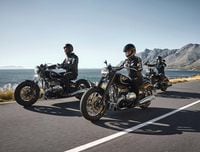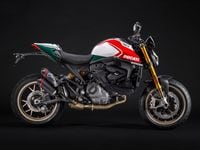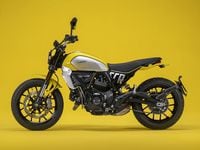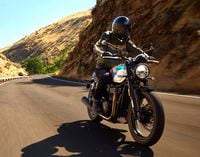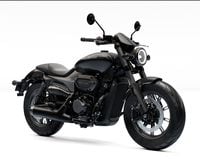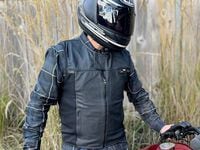This article was originally published in the April 2002 issue of Motorcycle Cruiser.
Once in a while, we Southern Californians are reminded what winter really means. Our sissy grins get frozen right on our faces, and the only sign of life is the panicked darting of our eyes. That's when we pull over and fall into a shuddering pile on the side of the road--our pampered bodies completely unable to cope. Our four-day Big-Twins test was just that sort of ordeal--freezing temperatures, wind, rain, hail and even a little snow thrust us into the reality many Americans deal with each time they open their garage doors in the winter. Our guest tester from Rhode Island just laughed.
The bikes, of course, were hot--11 of the most coveted large-displacement V-twins on the planet gathered for a competition of such considerable proportion no other magazine has dared take it on. The last time we rounded up the V-twins was in August 2000, and the list was remarkably different. Yamaha's Road Star took the cake then, but new entries were in the oven. For our 2002 test, we chose Harley-Davidson's FXDX Dyna Glide Sport ($13,995-$14,745) and Softail Deuce ($16,555-$17,840)--two bikes from decidedly different molds, although both epitomize the current performance trend. We included Honda's Retro VTX 1800 ($12,999-$13,499) since it's a new release for '02, and Kawasaki's Vulcan 1500 Classic FI ($10,599), Drifter ($11,799) and Mean Streak ($10,999). Suzuki's Intruder 1400 ($8349) and 1500LC ($9999) made the list, as well as Victory's V92C ($13,699-$14,299) with its revitalized motor and Yamaha's Road Star 1600 ($10,999-$11,199) and new, performance-oriented 1670cc Road Star Warrior ($11,999). The rules were simple: The bikes had to be V-twin powered and over 1200cc. (Therefore the 1100cc Harley V-Rod was excluded.)
Our test riders were as diverse as the bikes. We specifically chose people of various proportions so we could glean commentary that would cover a large spectrum of ergonomic potentials. Our smallest rider, Blaine Birchfield of Cobra Engineering was 5'5" and 175 lbs. Our largest tester, reader Paul Barry of Rhode Island, was 6'5" and 290 lbs. The rest of us ranged in between, from skinny to plump, short to tall. We were associate editor Andrew Cherney (5'7"/149 lbs), editor Jamie Elvidge (5'10"/135 lbs), Rhonda Hoffman of Planet Cruiser (5'8"/won't say), Doug Meyer from Muzzy (5'10"/182 lbs), beloved groupie Paul Posey of Georgia (5'10"/195 lbs) and Greg White, producer of our television show Motorcyclist on Speed Channel (6'3"/205 lbs). We had also invited reps from some of the manufacturers included in the test. We wouldn't be able to use their potentially biased ranking of the bikes, but we were able to milk their expertise and, in trade, offer a healthy chunk of comparative fodder to assist in future cruiser development. The OEM reps who were able to wriggle away from their desks for four days were Steve Rice of Kawasaki (5'11"/185 lbs), George Harmon of Honda (6'2"/180 lbs), and Brad "Barn-Burner" Banister of Yamaha (5'10"/170 lbs).
We used Death Valley, California, about 200 miles from our offices in Los Angeles, as a base camp. Situated well below sea level, it's usually the hottest place in the Western Hemisphere. It was 28 degrees F. the night we arrived. We bit our numb lips, however, and proceeded to make forays into the mountainous areas surrounding the fascinating Valley over the next few days. What we found (besides a serious ache for a hot bath each night) was that the world of big-twin cruisers had changed dramatically since our last comparison. It's a whole new ballgame, and not one that can be decided on a single playing field.
SKIN DEEP
Of course, our decision to recommend a cruiser is never based on styling alone, but it is a key factor. These bikes are designed for visual enticement, and all our contestants have pageant appeal right off the showroom floor. The first thing that made us realize this wasn't going to be our usual Big-Twins test, however, was how varied they looked when they were all rounded up in one pen--or in this case, the Denny's parking lot. Obviously, it's the addition of the performance cruisers that changes the herd so profoundly. Now you must choose between traditional and more aggressive, modern lines.
Honda's new-for-2002 Retro-version VTX 1800 is hard to miss--like a Budweiser Clydesdale at the Kentucky Derby. Not many of us thought this was a wise styling move since the bike is already so damn long and those gigantic valanced fenders only exaggerate the heft. People who like this look will also be drawn to the Indian-style appeal of Kawasaki's Drifter 1500. But all agreed the VTX is visually over the top, and the Drifter remains the king of the retro look. The Suzuki 1400 has its own retro thing going without trying. It's simply a design that's so old it's become classic. Some of us remain very fond of the bike's chopperesque attitude, though, and the clean way the chassis frames the motor as well as the fine job Suzuki has done hiding unsightly elements. Love it or hate it, the 1400 remains a conversation piece.
Then you have the classic cruisers--the bikes that embrace mid-20th century style, yet are finished and equipped to modern expectations. This category loosely includes Harley's FXDX, Kawasaki's Vulcan Classic FI, Suzuki's 1500LC, Yamaha's Road Star and Victory's V92C. The Classic walked away with inarguable honors here. Most liked the look of the Road Star--and especially its uniquely styled powerplant--yet all felt it would require a lot of aftermarket attention to look as nice as the Classic. The Victory garnered the widest swing in the style ratings. We think the motor looks better with the more curvaceous cans, but some still think it's visually bland. We do feel the bike's overall finish quality is finally on par with the metrics, even if some parts--like that Swiss cheese wedge for an ignition housing--are a bit gawky. The Harley FXDX with that flat black drive train and exhaust was more appealing to look at than it was to ride, but it still placed as ninth runner-up in the beauty contest. The Suzuki 1500LC was once again dog piled with more insults than praise despite its new wheel finish and more stylish turn signals. (Yeah, we know there are owners out there who think it's the cat's meow.)
The three street-rod styled bikes in the parade won a lot of praise for forceful styling and inventive visual features. Overall, the Warrior oozed more curbside sex appeal than the Mean Streak or Deuce, and everyone concluded it was the best-looking of the bunch.
Like people, bikes can be thought beautiful for many different reasons. It's all about what's important in the eye of the beholder, right? And you certainly don't need us to tell you whether a bike looks good to you. It either does or it doesn't.
The three street-rod styled bikes in the parade won a lot of praise for forceful styling and inventive visual features. Overall, the Warrior oozed more curbside sex appeal than the Mean Streak or Deuce, and everyone concluded it was the best-looking of the bunch.
Like people, bikes can be thought beautiful for many different reasons. It's all about what's important in the eye of the beholder, right? And you certainly don't need us to tell you whether a bike looks good to you. It either does or it doesn't.
THE COMFORT ZONE
In ranking the important features of a motorcycle, we follow these rules. Foremost, the bike needs to be comfortable or you won't want to ride it. When we rate comfort we look at riding position; handlebar, footrest and seat position and relations; functionality of controls; vibration and overall ride. Each participant in our Big-Twins comparison was asked to rank the bikes on all of these points separately and finally give each model an overall comfort score. Admittedly, this can be a subjective thing. What you'll find here are the averaged opinions--the bikes that do well by the widest variety of riders as well as some key points that may affect people of particular body types.
More of our riders were comfortable on the Kawasaki Vulcan 1500 FI than on any of the other bikes. Short or tall, none complained of being either cramped or stretched. It rated highest for general positioning, smoothness and long-range comfort. It's a Cadillac among cruisers and will offer a cozy, compliant ride whether you're going cross-town or cross-country. Kawasaki's Mean Streak was the next favorite for its overall comfort, followed by Harley's Deuce, although our larger riders found themselves a bit cramped by the H-D foot controls. The Road Star offered a comfortable seating position for just about everyone but emits noticeable vibration that put a few people off.
Our larger, longer riders really appreciated the space available on the VTX and 1500 Intruder, and the Suzuki offers a complaint ride. However, anyone under 5'10" felt both these bikes required too much of a stretch to be comfortable or instill confidence, and most everyone of every size felt the bar on the VTX was too wide. The LC also took top honor for the best stock seat, followed by the Road Star and the Classic FI. The Victory V92C offers one of the best riding positions in the group, but several people were annoyed by the bike's harsh suspension; it works well when you're riding the bike in fast corners, but really beats you up when you're just plugging along in normal situations.
The real losers in the accommodations department were the Suzuki 1400, which cramps even average-sized people, and the FXDX, which offers a decent ergonomic setup but transmits so much vibration you just want to shake the thing back and say "Knock it off!" Kawasaki's Drifter is comfy for short, low-speed rides, but the lack of passenger seat and pegs on the '02 edition limited people so much they simply didn't want to get on it for long stints. The Yamaha Warrior provided the least comfortable seating position with its exaggerated clamshell effect and huge engine accessories. The high desert winds only it made it worse, and when it was your turn to ride the thing all you could do was whimper.
As an interesting side note we found two different camps in the footpeg-vs.-floorboard department. Riders with bigger feet and longer legs tended to feel "trapped" by floorboards, which come standard on the Classic FI, Drifter, LC, Road Star, V92C and VTX Retro. Conversely, those with smaller feet and/or shorter legs found floorboards generally more desirable than footpegs.
THE MEAT OF IT
Next on our list of important features to look for in a new motorcycle purchase is the engine and drivetrain. These elements have a very visceral effect on us and are not as easy to tailor as ergonomics. In making our assessments we not only looked for the ultimate in gut-clenching power, we also judged the powerband for balance, starting and warm-up convenience and throttle response. For drivetrain evaluation, we single out clutch reaction and ease of use, efficiency of shifting, overall transmission behavior and any standout gearing characteristics.
But first things first. If you're looking at a big twin for your next cruiser you obviously have a taste for thrust. It's a particularly exciting class this year because so many of the engines are offering enhanced output. All of them offer dramatic low-end grunt, save the 1400, which is designed and geared to deliver more oomph on top. The pumped-up and refined Road Star motor found in the Warrior shines when it comes to sheer strength, and with its 76.3 hp toting only 658 pounds, it bested all the other bikes in the quarter-mile by pulling a 12.71 at 103 mph. The Warrior has a smooth drivetrain to match its intense motor. The VTX's 1800cc powerplant won out for emotional appeal and does offer the highest actual horsepower and torque readings at 94.6 and 105.1 lbs/ft, but unfortunately, it weighs in like an elephant at 796 pounds. We also suffered through some sticking-shifter problems on this bike, which eventually left us stranded in second gear. The problem turned out to be a kink in the shift linkage. The bike had to be hauled back to Honda, where it immediately went to R&D; for investigation. All that torquey power isn't much fun on the side of the road.
Harley's Deuce, which uses the counterbalanced Twin Cam 88 engine, was a favorite in the performance department as well. We had the fuel-injected version (it's also available carbureted), and it ran smoothly and pulled like a champ. Both Harleys lost some points for transmissions that don't engage as cleanly as their Japanese competitors and clutch levers that require an aggressive tug. The Victory motor is very comparable to the Twin Cam in output, but it's still a bit unrefined in character when ridden back-to-back with the counter- balanced Harley and most of the metrics. We do applaud Polaris for smoothing and finally quieting the bike's transmission though, and overall, the motor and drivetrain did rank much higher than in our last go-round. The Mean Streak is incredibly smooth and offers a placating amount of power, if not the commanding pull we'd expect from a bike aggressively marketed as a muscle twin. The Vulcan Classic FI is not far off the mark here. It uses an identical motor sans more aggressive cams enhanced injection and the lower gearing of the Mean Streak to deliver streetable grunt. The Drifter runs hotter cams, but carries more weight than the Classic. All three Kawasakis offer a flawlessly smooth drivetrain, and their Automatic Neutral Finder (which allows the box to shift only from first to neutral at stops) made them sweethearts for our many Chinese Fire Drill-style swaps. Both Harleys and the Victory required a fair amount of plunking around for the green light.
We've always wanted to like the Road Star motor more than we do. It's such a sweet-looking design, and that 1600 number just makes us expect some real power. It tools around fine and dishes out some nice flywheel effect but feels pretty darn anemic on top. Suzuki's 1400 remains a sprightly contender in the performance challenge thanks to an unencumbered chassis and aggressive gearing. This more dated shaft-drive design does produce some noticeable jacking though, and we all thought that it was just a bit too retro. After the conclusion of our test (which continued for six weeks after the group ride) the 1400 had badly glazed its clutch plates. The Harley FXDX Twin Cam pulls well, but its unbalanced nature made it a little too raw for even those hard-core H-D enthusiasts among us. It's also one of the only bikes that was a bitch to warm up on those ultra-cold mornings. Last and least, the Intruder 1500 motor and drivetrain continue to leave us cold. It's a heavy bike and really needs a little more oomph and a little less vibration coming from under the saddle. And while Suzuki has managed to improve the abrupt-release engagement problem in its clutch, there remains too much play before actuation and the engagement is still too sudden.
As for margins imposed by gearing and rev limiters, there were only a few complaints. Several people complained that the Intruder LC is overgeared. Almost everyone kept bumping against the VTX's limiter, and several riders had the same complaint of the Road Star's imposed ceiling.
THE COLD FACTS
About midway through our second balls-in day, all the testers had ridden the whole range of bikes long enough to start forming comparative opinions. We'd arrived at a little gas station in Lone Pine, California, where we stood around the deli counter trying to get our frozen hands to shovel some homemade potato chowder toward our blue lips.
We'd asked our guest testers to think about dozens of details, but that the bottom line should include two key things: Which of these bikes would you take home, and would it be the same bike if you had to buy it? The potato-chowder conversations were interesting. In all of our previous Big-Twin tests these questions had been pretty easy to answer. Now there was the "Which bike would I take home for what kind of riding?" component. "Am I going to ride it on weekends in the canyons? Tour on it? Commute? Or show it off at Bike Night?" Of course our answer was, "It has to do whatever is most important for you." But a door had been opened and we needed to explore it. The advent of performance twins seems to have put one too many hooks on the hat rack, and now these big cruisers have intentions that are so widespread, it had become questionable whether they could be collectively compared using the same formula.
On one side of the gas pump you have the classic cruisers--bikes that are built for show and as platforms for customizing more than power wars and canyon blitzing. Within that class you have ultra-retro styles like the VTX and Drifter as a sub-class, which really only appeals to a select group of enthusiasts. You also have some classics that are more easily turned into touring bikes. On the other side of the pump you've got these new performance machines, with a more hard-core intent. As we thawed out among the bewildered customers at that heaven-sent chowder-bearing service station, it was becoming more apparent that there could logically be more than one winner in this Big-Twin event.
HANDLE THIS
After a particularly curvaceous descent out of the mountains, we decided to park the bikes at the base so we could try them back to back, up and down the twisty stretch. Everyone was particularly interested to ride the new muscle twins in the tight stuff. We love that the manufacturers are chasing the performance trend and finally granting cruisers some of the qualities they should've had all along--like lighter chassis, good brakes, decent suspension and more useable power. So hurray and all that, but the fact is, we've still got a long way to go.
The Warrior is the bike everyone was waiting for to put a little sport in the big-twin cruiser arena (remember the V-Rod doesn't fit in this displacement category). After all, the new Yamaha is wearing a bunch of cutting-edge sportbike parts, including an inverted fork and swingarm lifted from the company's successful R1. We wanted it to go around corners like a wet kid on a waterslide--smooth and fast. The Warrior handles better than typical cruisers, true. But it's a bit quirky in corners, mostly as a result of the wide radial tires and a lack of damping in the rear. Initial steering is quick (some that like the feel of standard cruisers thought it was too quick), and the bike isn't one that you can just set in a line and forget. It requires management all the way through, especially if the corner is anything but smooth or you're carrying a lot of speed. In addition, it's hard to feel sublime when there are sparks careening off your footpegs.
Ground clearance is an area the manufacturers need to pay way more attention to, especially with cruisers intended for fast cornering. There is absolutely no reason why these bikes have to drag so much so soon. Harley-Davidson--the quintessential big-twin builder--figured it out long ago, and its bikes still offer better clearance than 95 percent of metric cruisers out there.
No one was as impressed with the Warrior as they wanted to be. It was the Mean Streak that wowed the crowd instead with its more stable mannerisms and quick-but-predictable steering response. (Our larger riders found the Meanie a bit undersprung in the rear despite air adjustment.) The Harley Deuce was another favorite. It's easy to ride fast--nimble and confidence-inspiring in corners although heavier to prompt than the performance twins with their high-tech forks. The FXDX, which each and every one of us detested in the straights, was also easy to pitch into a corner and tracked a line well. (Again, one of the fundamental reasons why people find the Harleys so nice to ride in corners is the superior ground clearance they offer.) The Victory V92C placed well in the cornering wars, winning high scores for smoothness and stability. That stiff suspension that bothered everyone on the highway is right at home in fast corners as long as they aren't too bumpy. The Victory steers sweetly after a bit of a push and tracks a corner like a hound dog on the scent.
Kawasaki's Vulcan Classic--our does-everything-well-entry--didn't receive overt praise in the handling department, but no one had serious gripes either. It's predictable and pleasant in low-speed corners, although both the front and rear suspension is soft, which causes some wallowing in fast stuff and exaggerates the bike's lack of ground clearance. The Drifter's cushy suspension, although nice on the open road, didn't receive good marks for cornering. One tester likened it to "riding a trampoline."
Suzuki's 1400 was pretty darn fun to ride fast. It's well sprung and small, making it easy to flick around. In low-speed situations, however, the Suzuki's tall, skinny chopper-style front wheel is pretty twitchy, and in anything loose--like gravel--it's all over the place. Just ask Paul Posey, who was skirting a frozen puddle on a gravel road when the 1400's front end started dancing around. It took him right over a two-foot dirt berm and into a field of boulders. (Good thing the bike's light, so we could lift it back on the road.) The Road Star is smooth and we like it for its low-speed maneuverability. But its soft suspension and unacceptable lack of ground clearance made it a dud for fast riding. The VTX Retro is an absolute barge compared to the whole lot of big twins, a result of its length and absurd tonnage. As one rider said, "If I wanted a truck I'd buy one." The VTX was even last to the Intruder LC, which up until now had always been the object of our obese-bike jokes. The standard VTX does much better than the Retro version in corners, although both are too long and heavy to be called good handlers.
BRAKE IT UP
It's about time cruiser brakes worked well. It always seemed rather rude to us that the manufacturers would put their least sophisticated systems on their heaviest motorcycles. Harley started the much-needed trend when it introduced four-piston calipers on its heavyweights in 1999. In our last comparison, the Brembo-equipped Victory out-stopped all the other big twins, but this year both the Mean Streak and Warrior have outdone both American companies.
The new Kawasaki, with its triple-piston dual discs up front and single disc out back, provides supreme feel and the shortest stopping distance. We love these brakes. The Warrior nearly matches the Mean Streak with its dual-action, twin-piston front and single-disc rear system and is followed by the Victory to round off the top three. The majority of the bikes drew adequate grades for braking performance, although the two Suzukis and the Drifter received more than one negative comment regarding vagueness of feel and dull response. Suzuki's LC gained an additional disc up front this year, bringing it up to spec with the rest of the big twins. Braking feel on the bike remains mediocre.
Most of us got along fine with the linked braking system on the VTX, which appropriates 30 percent of power from the dual front discs to the foot pedal while the remaining 70 percent of front brake action is independently controlled by the hand lever. While the system doesn't offer the dramatic feel of the Streak, Warrior or Victory, it steadily slows the weighty beast and may well be a safety benefit to those riders who over-favor the rear pedal.
IT'S THE LITTLE THINGS
So if you're going to shell out over 10 grand for a high-end cruiser you're going to expect a few bells and whistles, right? Certainly these bikes should offer a few extra goodies. Only some do. The FXDX, Mean Streak, Victory and Warrior are the only entries to offer tachometers, and the only ones with clocks are the Classic, Mean Streak, Road Star, Victory and Warrior. Kawasaki's Vulcan Classic is the only bike that offers decent bungee-cord hooks. The Victory features our staff's favorite instrument arrangement with an LED display that is controlled by two toggles on the backsides of each handlebar switch housing. Readings are available for electrical and engine condition, fuel quantity, odometer, trip meters and time. This LED panel, which is adjustable for brightness as well, is located within the headlight-mounted speedometer that also incorporates an analog tach. However, on the tour portion of our test more people voted in favor of the Mean Streak's arrangement, perhaps because the Victory system takes some getting used to. The Deuce was also a favorite in this category for its readability and classic, clean styling (even though it lacks a tach).
The Warrior received many compliments for its ultra-cool-looking gauge setup, which shines indigo blue at night. Engine rpm is displayed on a digital graph atop the headlight, while the analog speedo is incorporated into the handlebar riser. Most everyone found the gauges difficult to read during the day. The Road Star has a good-looking arrangement, but it's positioned on the tank and too low to read easily while you're on the road. The same is true of the Vulcan FI and 1500LC. All the bikes offer fuel gauges (a must for injected bikes that don't use reserve) except for the Suzuki 1400, which has always been the first big twin on these tests to run out of gas. (Its tank holds only 3.4 gallons.) On this trip, however, the Mean Streak and the Warrior both petered out at least once before the 1400 ran dry. It may have had something to do with the fact that all the fast bikes seemed to disappear each time the road opened up, while bikes like the Suzuki 1400, 1500LC, Road Star and FXDX consistently brought up the rear. Some bikes just aren't built to fly.
Fuel-capacities-vs.-mileage data placed both Harleys on top (as usual) with averaged ranges that exceed 200 miles. The only bikes that come close to these numbers are the VTX (39-mpg average and 207-mile range) and Victory (33-mpg average and 165-mile range).
Packing soft luggage on most of these bikes was a launch-souring chore. The new muscle bikes with their bobbed fenders add the challenge of keeping the saddlebags away from the wheels. The Drifter, obviously, was impossible to pack anything on since it has no rear seat. Many of these bikes also come with silly baguette-size passenger seats, which make it hard to balance even the smallest load. The worst bikes to pack on (aside from the Drifter) were the Warrior, Deuce, Intruder 1400, FXDX and Mean Streak, in that order. Bikes that more readily accepted luggage were the Vulcan FI, Road Star, Intruder 1500, V92C and Retro VTX. The Kawasaki Classic was by far the most amicable.
Aside from the Honda needing a lift home, we had only a couple of hassles on the road. The FXDX rattled off a filtercover, and the Mean Streak left an exhaust-system heat shield out in the desert. The Meanie also suffered reoccurring taillight failure--not only an inconvenience but a real safety issue. Replacing the rectifier was required to completely correct the problem. When you're switching bikes every 30-40 miles mirrors are adjusted constantly. Most survived this abuse, but the antiquated multi-thread stem-in systems on the Suzukis required a wrench more than once.
ALL HEROES RISE
So what knowledge did we bring forth from the frigid desert--aside from the awareness that snot hurts when it gets frozen in your nostrils? We learned that big-twin cruisers are no longer one class of motorcycle, and that this test would require more than one winner.
Once the four-day scores were tallied, the staff spent another six weeks confirming the marks. Here's what we found. At the bottom of the heap, and no matter how we shook up the mix, was Suzuki's 1400 Intruder. Yes, it has a very appealing price tag of $8349, and for someone who's not too ambitious and doesn't care that his big twin feels like a toy, it may be a fine choice. For the price, it's a great platform for customizing, on that we all agree. However, we prefer most of the 800s and all of the 1100s available to the Suzuki 1400 for the same kind of cash. Our other least favorite was Harley's FXDX Dyna Glide Sport. It's really pretty fun in corners, but its unbalanced motor and generally unrefined demeanor made us cringe. Fourteen grand is too much to pay for a vibrator. (Strangely, this package works great in the T-Sport edition of the Dyna Glide, and makes us wonder whether our test unit wasn't a particularly bad specimen.)
With the release of its 800 Volusia, Suzuki has shown us it can make a great cruiser. Unfortunately, it's the company's only strong example to date. The 1500LC continues to put us off with its dull motor, unimpressive styling, sub-par detailing and generally lackluster feel despite its tempting price of $10,000. Perhaps Suzuki's new affiliation with Kawasaki will speed up delivery of some worthy cruisers. Honda's Retro VTX is too much of a good thing. The standard VTX rocks and would have pulled a much higher ranking than its obese counterpart (which also happened to go home in a truck, which cost it major points). Had the standard VTX, with its sexy looks and less overwhelmed, overloaded chassis, been included we believe it would have placed fifth in the overall standings. Kawasaki's Drifter 1500 is a nicely styled bike with beautiful details, if you're into that sort of thing. Most aren't. Its wallowing nature, lack of packing space, no passenger accommodations and few hot-ticket high points leave it in the seventh position.
The Yamaha Road Star and Victory's revamped V92C just about tied at mid-pack. The Victory was a real surprise to everyone who hadn't ridden one, and it nudged in above the Yamaha for its sheer dark-horse charm (despite its steep price of over $13,000). We were all impressed by its open-road strength and around-town civility. The bike just continues to improve each model year as Polaris rains upgrades on its big-twin-cruiser efforts. And people continue to feel fond of the Road Star. It has enormous visceral appeal and is appropriately priced at $11,000.
The top four? These bikes fall into different notches each time we bend the priorities. They are the most desirable big twins on the market today, and for different reasons. The Warrior earned very high marks in specific categories. When it came to rating power, handling, braking and appearance it scored all As and Bs (except for some Cs and Ds in the ground clearance and stability columns). The bike sucked in more everyday departments like comfort and practicality, though. It's like a gorgeous woman who looks good for a hot date, but doesn't cut it for coffee and the Sunday paper. Every time we look at this bike we're turned on...then we get a half-day down the road and want to turn around. And its quarter-mile time of 12.71 does make it the champion among stock big twins at the drag strip (just keep it away from those "little" V-Rods).
If classic styling were still the yardstick, and if overall balance and function were regarded more highly than a bike's power and handling, Kawasaki's Vulcan Classic FI would walk away from this competition the King. And it still deserves a crown. This bike physically suited more riders than any other, and almost everyone said they'd choose it first if they were headed for Omaha. It does everything well, if not one thing exceptionally well. It is the best classically styled big-twin cruiser for the price ($10,599). But if price weren't an issue almost every one of our testers would own a Softail Deuce ($16,555 and skyward). This bike had intense appeal across the board. It looks great without being over-the-top. It has nice, smooth power, beautiful finish quality and detail, handling that's right up there with the performance twins and that neat bad-boy stance that places your body in a posture that would make the Pope look cool. But not one of our testers would be willing to lay down that kind of cash for one.
Have you guessed the overall winner? It wasn't as straightforward for us--but the figures from our rating charts don't lie. Kawasaki's Mean Streak is toted as a muscle twin, but its motor isn't very brawny, especially compared to that of the V-Rod, VTX or Warrior. Its styling certainly screams of fast intent, but the bike is much more gentlemanly than its aggressive appearance portends. In every category the Mean Streak earned honor-roll grades, though. Like the Vulcan Classic FI, it does everything well, but unlike its more subtly styled stablemate, it does some things exceptionally well. Balance is the key to what makes the Mean Streak the overall winner here. It offers new-world excitement with a stimulating motor and inspiring yet predictable handling qualities, without giving up comfort and convenience. It looks hot, it's fun to ride, and it's affordable at $10,999.
So there you have it...or them. The Mean Streak is the best all-around big-twin cruiser 2002 has to offer. If you're not into the street-rod look, though, or want a bike that's more Sunday paper than seductress, the best big twin is the Vulcan Classic FI. Sky's the limit and passion rules? The tiara belongs to the Deuce. You stack 'em as you see 'em. The winner will be you.











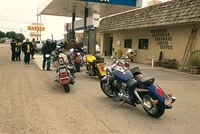
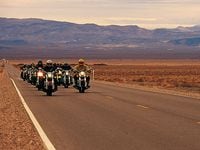
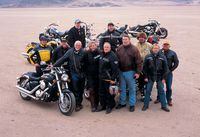
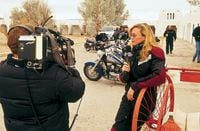
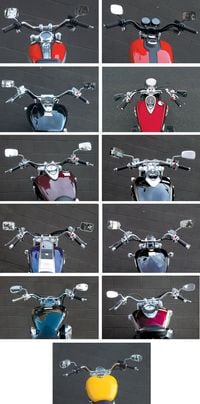
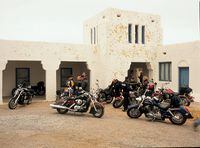
/cloudfront-us-east-1.images.arcpublishing.com/octane/URZBW5LIV5BIXMBTOKHIDHMIPM.jpg)
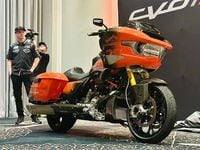
/cloudfront-us-east-1.images.arcpublishing.com/octane/6KKT5NNL2JAVBOXMZYS5ZO76YA.jpg)
/cloudfront-us-east-1.images.arcpublishing.com/octane/H6Z2IC7WYRBXZNQS4MI3SZ5KPQ.jpg)
/cloudfront-us-east-1.images.arcpublishing.com/octane/IWO5T5PBT5E4HFQ5GK47H5YXR4.jpg)
/cloudfront-us-east-1.images.arcpublishing.com/octane/OQVCJOABCFC5NBEF2KIGRCV3XA.jpg)
/cloudfront-us-east-1.images.arcpublishing.com/octane/F3O2DGLA4ZBDJGNVV6T2IUTWK4.jpg)
/cloudfront-us-east-1.images.arcpublishing.com/octane/ZXYQE3MHLFDSPKNGWL7ER5WJ4U.jpg)
/cloudfront-us-east-1.images.arcpublishing.com/octane/RDF24VM7WVCOBPIR3V3R4KS63U.jpg)
/cloudfront-us-east-1.images.arcpublishing.com/octane/W7RSIBFISNHJLIJESSWTEBTZRQ.jpg)
/cloudfront-us-east-1.images.arcpublishing.com/octane/AERA26ENRNBW3K324YWCPEXYKM.jpg)
/cloudfront-us-east-1.images.arcpublishing.com/octane/YWX3YX7QBBHFXFDMEEEKRG4XJE.jpg)
/cloudfront-us-east-1.images.arcpublishing.com/octane/I7OKI53SZNDOBD2QPXV5VW4AR4.jpg)
/cloudfront-us-east-1.images.arcpublishing.com/octane/IH52EK3ZYZEDRD3HI3QAYOQOQY.jpg)
/cloudfront-us-east-1.images.arcpublishing.com/octane/K2FSAN7OWNAXRJBY32DMVINA44.jpg)
/cloudfront-us-east-1.images.arcpublishing.com/octane/G4XK7JL24FCUTKLZWUFVXOSOGE.jpg)
/cloudfront-us-east-1.images.arcpublishing.com/octane/JJNXVAC27ZCDDCMTHTQZTHO55Y.jpg)
